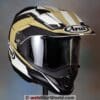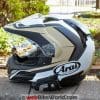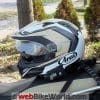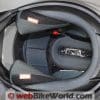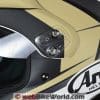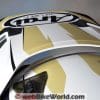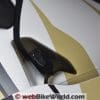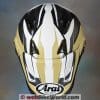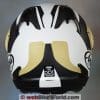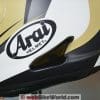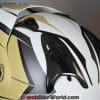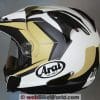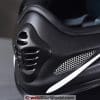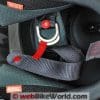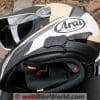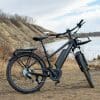The Arai XD4 for 2015 includes some new features inside and outside that make it a winner in virtually every category.
As a long-time user of Arai helmets (typically theCorsair (review) and XD models), the 2015 version of the Arai XD4 in Flare Sand Frost is the third XD I have owned.
My first was acquired in the summer of 2007.
And outside of acknowledging my favourite flip-up helmet — a SCHUBERTH C3 Pro (review), Mr. Arai remains my milliner or “hatter” of choice.
Although a well-used cliché, the newest XD4 feels just like an Arai as pulled from the box and put onto the head — no muss or fuss, just comfort.
The new patterns are edgy and distinctive with four colour schemes each in the Diamante and Flare patterns; both offer a great mix of popular colours that should please many.
The Aluminum Silver, Black Frost, Black and Fluorescent Yellow solid colours are also available.
Notable changes are even more effective top brow vents, larger side cowl vents and increased air flow through the chin vents.
Enhancements to the top and side shell cowlings result in better aerodynamics, improved air flow, more efficient vent diffuser management and less noise.
On the inside, newly reshaped FCS (Facial Contour Support) cheek and brow pads with 5 mm peel-off foam layers provide increased comfort, support, fit customization and contribute to noise reduction along the bottom of the helmet.
And although I haven’t installed it yet, Arai has a selection of clear and coloured Pinlock inserts available for this newest XD4.
That is a valued safety feature in preventing interior fogging in cold/wet/damp climates especially for those of us who wear eyeglasses full time.
Last, but certainly not least, the much quieter 2015 XD4 meets both the DOT standard and the updated Snell M2015 Standard (report) like other new Arai models.
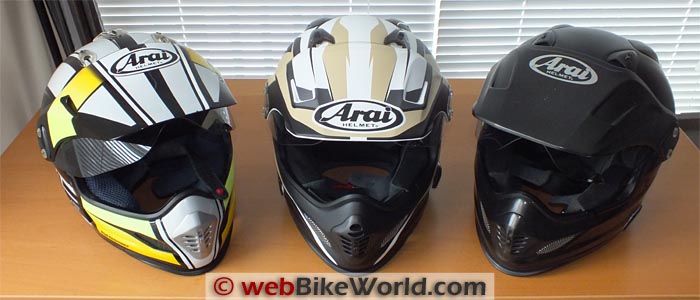
The Arai XD4 for 2015
In the original Arai XD4 helmet review from 2012, Bill stated that, to a certain extent, the XD4 is in a class of one.
And even though competition has emerged over the intervening two years, the Arai XD4 arguably remains the standard for premium dual-sport helmets.
With its familiar Arai R75 or “Radius 75 mm” exterior profile, the XD4 has an intermediate oval interior shape which for me provides day-in, day-out comfort right from day one.
And while not specifically identified on the back of the shell, this newest XD4 is certified to the updated Snell M2015 standard.
There is no denying that adaptability remains the XD4’s forte; it can go from the dust and dirt of off-road or adventure-touring to high-speed pavement in seconds with the peak or by a simple removal of the face shield for goggle use. Or, remove the peak to create an outstanding high-speed aerodynamic shell.
I’ve used all three configurations possible with XD/XD3/XD4 helmets over the years and this adaptability and level of performance is hard to beat in a full-face helmet model.
The peak has been evolved a great deal since its original form and despite its size and positioning it is superbly shaped for streamlining and flow-through.
Although as I mentioned before, its presence can still be felt depending on the motorcycle ridden.
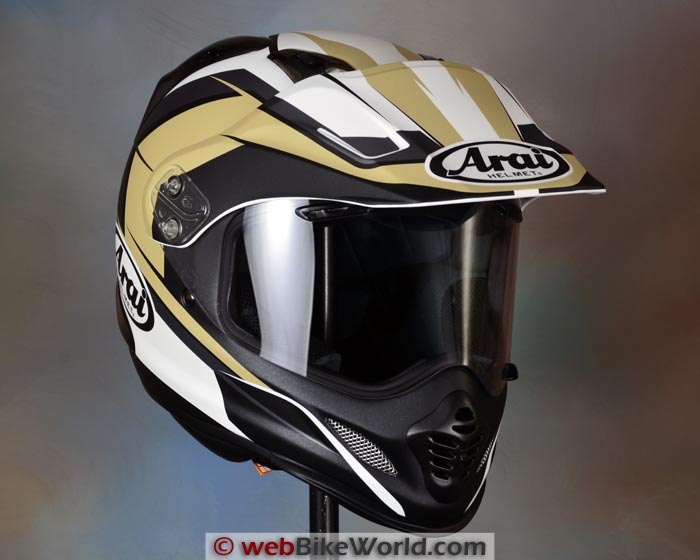
Paint, Graphics and Overall Quality
The new-for-2015 XD4 patterns are available in eight colour schemes (four per scheme); both patterns are eye-catching, aesthetically simple but visually stimulating…although the Flare pattern caught my eye and wouldn’t let go.
So while typically being a function-over-form type of rider, I must admit to some capitulation to vanity in going for the Flare Sand Frost matte finish.
It is a near-perfect match for the Sandrover finish used on the 2014 F800GS Adventure sitting in my garage.
Most helmets today, in almost any price range, are so well made that it can be hard to find real issues in their graphics and finish, although trim and component mating issues can still be found, no matter the price and reputation.
And this last issue if you will that is the only observation made by the Editor and myself regarding the new XD4 although nothing else regarding graphics, paint or overall quality was identified; about what we have come to expect from Arai helmets.
The “issue” relates to the complex-shaped face shield and how it fits or mates to the weather seal molding around the cut-out.
Admittedly the face shield feels lighter than some other face shields on other helmets, but one has to appreciate the aforementioned complex curvature.
As designed, the face shield when it is just pushed down sits 1-2 mm from the weather seal, serving to keep most moisture out while allowing some air flow to reduce fogging of the shield on cold damp or rainy days.
This is especially important for those of us who wear glasses all the time and when the Pinlock option isn’t fitted (yet).
With the face shield pushed down to the sealed position, engaging the left side lock tab yields a centre mating that is very good, but not absolute on the left and right as the shield and helmet curve upwards.
Loosening and repositioning the shield doesn’t serve to resolve this, but increasing the thickness of the seal 1-2 mm would.
The only other observation was made by the Editor before sending the helmet up for my evaluation. He thought the peak was a bit “wonky” and had wondered if it was not formed properly.
But in knowing and appreciating the flexibility and adjustability of the XD4 peak a couple of quick adjustments using the side mount screws got things squared off.
The external intake and top diffuser vent port cowlings are opaque tinted plastic and actually add to the overall look of the helmet.
The tint is light enough that strong or natural lighting allows some of the helmet scheme to show through.
Score: We’ll give the Arai XD4 an “Outstanding” rating for excellent build quality, finishing and solid-feel. See the Summary Table at the bottom of the page for a description of our rating system.
Helmet Fit, Internal Shape and Liner
The Arai XD4 retains its intermediate oval head shape courtesy of the exclusive one-piece multiple density EPS liner.
The Complex Laminate Construction (CLC) and Hyper-Ridge (the reinforcement band that circles the bottom of the shell to add strength while lowering the centre of gravity) are the other standard and valued XD4 features.
Arai’s patented Facial Contour System (FCS) cheek pads have been updated and while appearing a bit thin and overly light, the pieces provide great comfort and firm support while helping reduce interior noise as well.
And they come with a unique customization capability, with the peel-away 5 mm custom-fit layer sandwiched between the other variable density foam layers for each owner to get a more perfect fit.
The 2015 XD4 also has a 5 mm removable layer with the side temple pads so that more interior width can be provided if needed.
A reduction in interior noise levels with the new cheek pad design is very noticeable.
That’s because they block more of the wind noise from entering the bottom of the helmet, much of which is generated from turbulent airflow above the rider’s shoulders.
This can be especially noticeable on motorcycles that have minimal or no frontal protection.
My original Arai XD (review) was a size medium with a custom-fitted interior, but the Arai XD3 (review) and now the 2015 XD4 are a size large.
I’m on my third set of 20 cm cheek pads with the now-retired XD3, but the 15 mm pads in the new XD4 with the 5 mm removable layer intact provides an even better firm but oh-so-comfortable fit.
Accommodation for eyeglasses — something never found wanting on Arai helmets — remains top notch.
That makes a good first impression regarding ease in putting the glasses on or removing them with the helmet mounted and resultant comfort with no undue pressure points.
This is true even with an older heavy frame pair kept on hand for this type of fitment test.
Another tried-and-true Arai standard on the XD4 is the Emergency Cheek Pad Release System, developed to allow easier access to an injured rider.
The specially shaped and mounted pads slide out easily using the integrated and highly visible bright orange pull-tabs.
With the cheek pads removed, helmet removal by trained first responders or medical personnel is greatly facilitated and it is a feature being adopted by more and more helmet manufacturers — never a bad thing.
Actually, all of the interior liner pieces are removable.
Arai’s modular multi-part approach allows removal of the pieces for cleaning or replacement due to wear and tear or re-sizing of components if needed for fitment purposes.
Arai offers a full size range for each component.

More information on helmet fit can be found in the webBikeWorld Motorcycle Helmet FAQ page, along with the chart that lists the helmet weights of webBikeWorld reviewed helmets and also by shape on the webBikeWorld Motorcycle Helmet Shapes page.
Score: We’ll give the XD4 an “Outstanding” rating for shape, comfort, padding and fit.
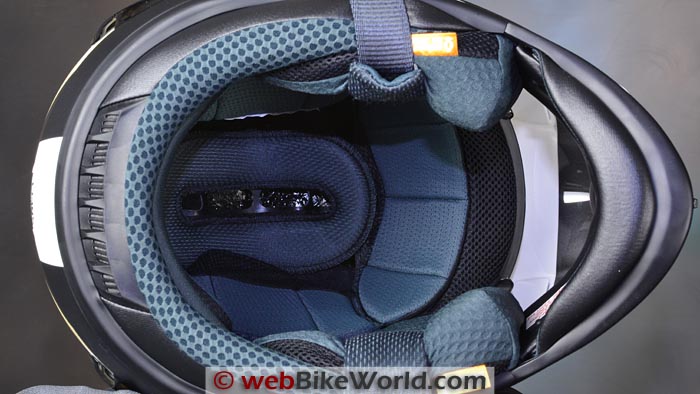
Face Shield, Eye Port and Outward Visibility
The XD4 does indeed have a somewhat complex-shaped face shield but outside of the already mentioned and minor alignment or fit issue against the weather seal on the shell, the eye port and face shield combination allows great visibility.
That includes up, down, forward and peripherally; it’s equal to or better than other adventure touring and off-road helmets I’ve tried.
Adding the upper brow vents to the face shield may have increased the complexity and cost, but the advantage gained in improving upper air intake and flow through the helmet and thus the head cannot be argued.
The eye port itself is of similar shape and area to the Arai VX Pro4 (review) and similar iterations, so the XD4 will accommodate most goggles, although if fitting a pair, it pays to do some test fittings first.
The visor, peak or whatever you want to call it is truly meant to complement the adventure touring or off-road experience and it does in virtually every way, including ongoing shade and a very good deflector of flying objects.
Removing the visor/peak and/or the face shield and using the secondary side plates is easy, although not as simple as many other systems on the market.
But these options do allow expedient reconfiguring of the XD4 to meet other requirements.

Score: The XD4 has excellent eye port visibility overall, so we’ll give it an “Excellent” rating overall.
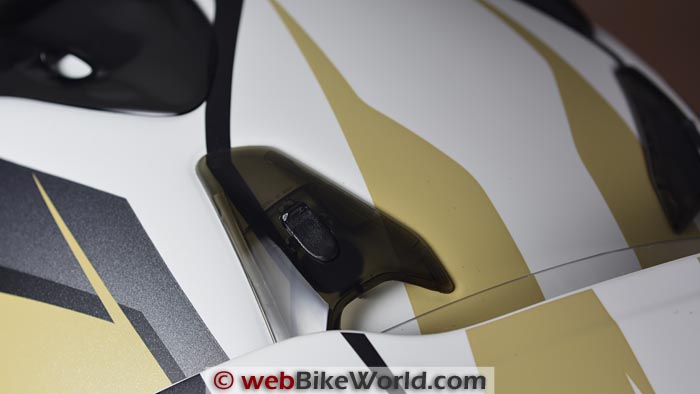
Top Vents and Ventilation
Arai XD helmets have always had excellent ventilation in using a multitude of intake and exhaust vents; five alone on top of the original XD helmet with two small slit vents on the sides towards the back.
But this same abundance of (top) vents generated more than a few complaints related to noise levels (open or closed) with the original and to degrees with subsequent versions of the XD helmet.
For many users, it seemed there was a conspiracy of shape, size and positioning that culminated to generate noise.
An expedient solution was to cover the forward top vents with tape which served to dramatically reduce noise levels depending on the cockpit environment and the motorcycle being ridden.
Thankfully, Arai has been addressing this and related issues through continuing enhancements of the XD model.
In having a late production version of the original XD on hand along with the XD3 and now the 2015 XD4, the visual differences in the helmets, especially venting, are easy to see and feel.
The XD’s five top ports — two front intake, a centre exhaust and two rear exhaust — were well positioned, but the front two were indeed just plain noisy.
The XD3 saw a major change in the adoption of four ports; two large low profile intake housings on top and two large stylized housings covering vents towards the rear.
The changes reduced but didn’t eliminate noise; but I only had to resort to the tape cure once for a particular motorcycle ridden at speed.
For 2015 the XD4 has the same top housing layout as the XD3 but with visual and functional changes.
The two front pieces are more shaped and a bit more rounded than the XD3 pieces while the rear components are essentially the same but now sport small stylized cut-outs on each side of the housings.
These flow-through ports decrease air pressure build-up against the housing reducing noise and increase pull-through in exhausting head-heated air from inside.
Does it all work to decrease noise levels and provide more efficient air management? Yes it does, in spades.
The side rear oriented ports also received reshaped housings that more closely mimic the shape and contour of that part of the helmet shell especially the very distinctive and effective aerodynamic ridge in the shell between these two vents.
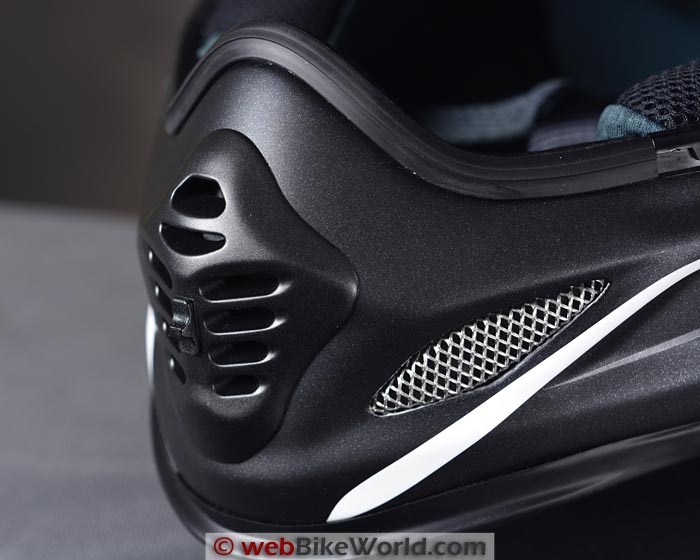
XD4 Chin Vent
The chin vent is another positive component for effective air management on the XD4 and for 2015 it now provides even better air flow via the patented dual-pivot chin vent that features external and internal adjusters or sliders.
Pushing the external slider control up on the main front chin vent shutters or closes the vent completely for a great seal and pushing the control down opens it.
When open, the chin vent provides a rush of fresh air that can be directed in two ways.
With the internal slider pushed down (open), air flows directly to the mouth area and around the lower part of the head up into the helmet.
In the up (closed) position, incoming air is directed up along the inside to the interior side of the face shield to prevent fogging; a good thing — trust me on this one.
And we can’t overlook the two stylized mesh-covered openings on each side of the chin section of the shell. They are fully functional vents with small tab-sliders on the inside and when open enhance lower shell air flow.
If left open while riding on a cool pre-spring day, you’ll probably realize that they might need to be closed!
Although found on the original XD4 helmet, the adjustable brow vents in the XD4 face shield and companion intake ducts positioned on the brow of the helmet have seemingly received an update as well.
With the face shield closed and the brow vents open a direct flow of air in and onto the left and right temple areas via the small outlets that peek out of the back of the liner material.
This flow helps cool the head and thus the brain (don’t be a “hothead”) while keeping stale air pushed out the exhaust vents.
Summary: the 2015 XD4 provides better airflow and airflow management than previous models. .



Score: We’ll give the XD4 ventilation system an overall “Outstanding” rating.
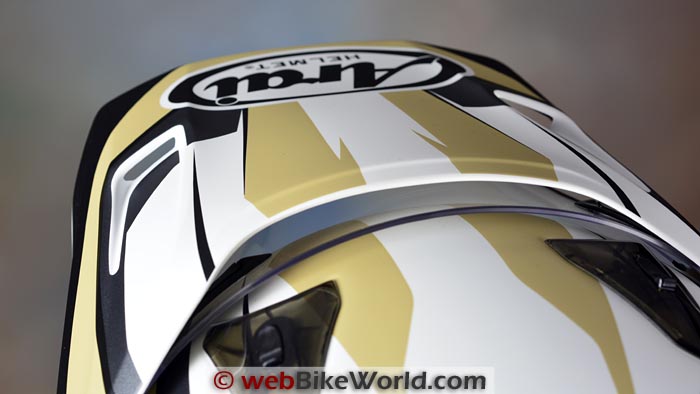


Noise Levels
Aerodynamics are a major factor in managing noise levels, particularly with the XD4 that features a more protruding front or chin section and a prominent but very functional peak or visor.
These are features that can be bot positives and negatives overall.
But the newest XD4 has a grip on the noise issue; it’s not perfect when compared to more stream-lined helmets with better aerodynamics.
But it does an outstanding job of dealing with a multitude of cockpit environments that may or may not be enhanced by some level of frontal coverage.
Between its super-efficient shaping of the peak/visor and the revised venting, and lower shell changes, the seemingly minor and subtle changes to the helmet provide reduced noise levels; this continued refinement thing really works, eh?
And although the pull-down chin spoiler or curtain gets mixed reviews, for me it is something that I look for and use depending on the motorcycle and of course the temperature; pulling the spoiler down can be very effective.



Note that our helmet evaluations are a combined effort of several riders over time on different types of motorcycles with and without windscreens.
Evaluators wear correctly fitted, high quality ear plugs (even when evaluating motorcycle intercom systems).
Always protect your hearing when riding a motorcycle. See the wBW Earplug Reviews for more information on choosing and wearing earplugs.
Note also that perceived noise levels will vary, depending on the individual.
Noise can be caused by many factors, including helmet fit, the type of motorcycle and windscreen, wind speed and direction and even the rider’s clothing.
For more information on helmet noise, visit the wBW Motorcycle Helmet Noise page.
Score: We’ll give the XD4 for 2015 a “Very Good (to Excellent)” rating for noise control.
Helmet Weight
The 2015 Arai XD4 in size large tips the wBW scales at 1642 grams, with a few grams added for the low profile ultra-light Sena SMH10R (review) now installed.
So with the original Arai XD (review) in XL coming in at 1693 grams and the Arai XD3 (review) in size large tipping the scales at 1675 grams, the new 2015 XD4 is clearly the weight champion among the XD models.
Note also that all of the weights of the helmets reviewed on webBikeWorld are available on the wBW Motorcycle Helmet Weights page, along with a chart that lists the helmets by weight and shape on the wBW Motorcycle Helmet Shapes page.
Score: We’ll give the 2015 Arai XD4 a “Neutral” rating for its weight with good balance.
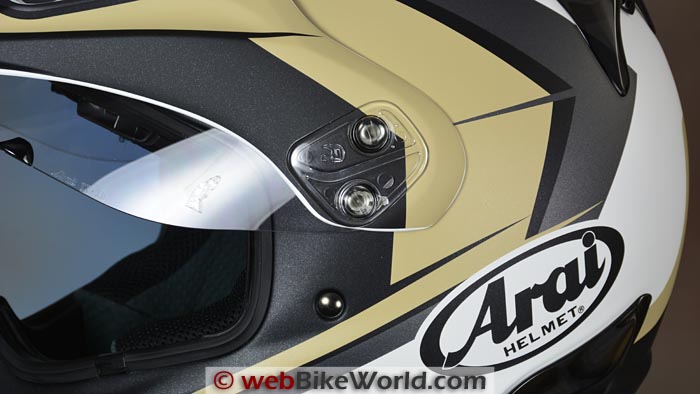


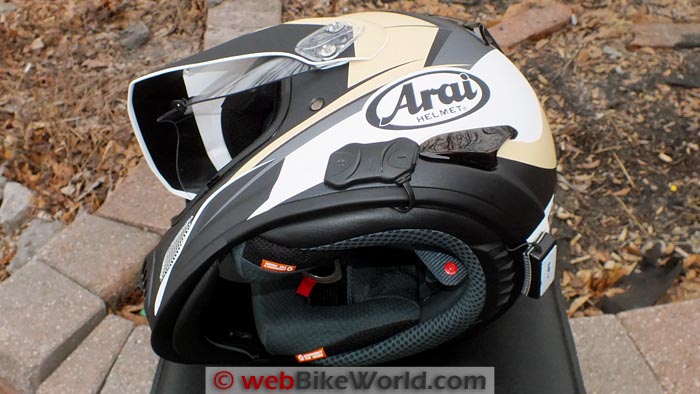


Miscellaneous
The XD4 uses a double D-ring chin strap, a feature that I prefer although it isn’t for everyone.
But an oft-noted issues still remains.
The cushion padding sections are indeed a bit short; depending on head shape and size the sections may not meet when the helmet is secured and the resultant gaps could be uncomfortable.
In the box were the usual secondary side pieces meant for use when peak/visor (and face shield) is removed to keep the attachment and adjustment points covered and of course maintain helmet aerodynamics and look.
Don’t lose them, and use them is my motto.
Also inside was a dark face shield; having a second shield is always good as even the hardened Arai shields don’t last forever and they do cost.
But I never use a dark tint, despite some light sensitivity, opting instead for transition lenses or dedicated prescription eyeglasses and a light tint face shield.
Like most Arai face shields I have used over the years, the clear shield used on the new XD4 is great optically, but as noted earlier a Pinlock shield is high on my list, with perhaps a clear and amber tint insert acquired for use.
Finally, Arai provides a five year warranty on the XD4, which effectively covers the life of the helmet.
- Arai look, feel and quality.
- Fit, fit and fit!
- Outstanding paint and finish.
- Ventilation now even better than other versions.
- New/revised interior pads provide outstanding comfort…and allow fit customization.
- Flowing design and venting of large peak works as intended.
- Flare Sand Frost nice match for Sandrover panels on F800GS Adventure.
- Thin and short chin strap padding may be an issue.
- A small gap between the face shield and weather seal on the sides with the face shield closed.
- Not as quiet as the quietest.
- High price.
Conclusion
I get to ride a lot of different two- and three-wheeled machines from basic to full-dressed touring rigs and everything in between, including three-wheelers in the traditional side-car style and the BRP Spyder.
And within this diversified platform environment the XD4 just works, despite its overall visual looks. Everything flows aesthetically and in a practical sense as well.
The latest housing and venting changes all work together for better airflow over, around and through the helmet, creating a quieter environment to boot.
Winter and Spring weather didn’t give me reason to change my view that the Arai XD helmets are still among the best all-round helmets used on two or three wheels.
On occasions when the peak/visor becomes a liability on any of the XD-series helmets, it can be removed in a minute or less and the secondary side covers installed to keep everything covered for streamlining and the “look”.
Without the peak, the XD4 helmet looks and functions like other great aerodynamic full-face helmets, so the choice is yours.
The 2015 XD4 is a very big improvement in every category from my XD3 and is leaps and bounds ahead of the original XD.
Both of those previous helmets are literally worn out with use and time (three to four years being my replacement standard).
Yes, Arai helmets continue to be seen as over-priced.
But for some of us it is just the price to be paid for what is arguably the best helmet available; never a bad investment.
Also: Original Arai XD4 Review
Owner Comments and Feedback
See details on submitting comments.


